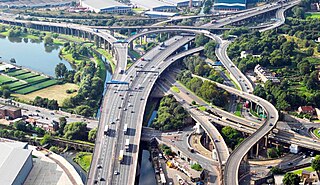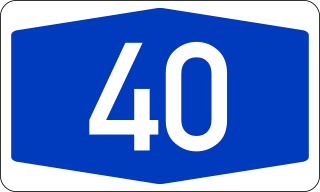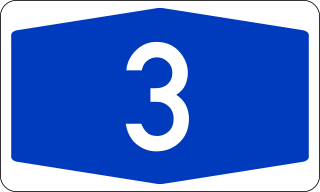
The Ruhr, also referred to as the Ruhr area, sometimes Ruhr district, Ruhr region, or Ruhr valley, is a polycentric urban area in North Rhine-Westphalia, Germany. With a population density of 2,800/km2 and a population of over 5 million (2017), it is the largest urban area in Germany and the third of the European Union. It consists of several large cities bordered by the rivers Ruhr to the south, Rhine to the west, and Lippe to the north. In the southwest it borders the Bergisches Land. It is considered part of the larger Rhine-Ruhr metropolitan region of more than 10 million people, which is the third largest in Western Europe, behind only London and Paris.

Duisburg is a city in the Ruhr metropolitan area of the western German state of North Rhine-Westphalia. Lying on the confluence of the Rhine and the Ruhr rivers in the center of the Rhine-Ruhr Region, Duisburg is the 5th largest city in North Rhine-Westphalia and the 15th-largest city in Germany.

Spaghetti junction is a nickname sometimes given to a complex or massively intertwined road traffic interchange that is said to resemble a plate of spaghetti. Such interchanges may incorporate a variety of interchange design elements in order to maximize connectivity.

Bundesautobahn 1 is an autobahn in Germany. It runs from Heiligenhafen in Schleswig-Holstein to Saarbrücken, a distance of 749 km (465 mi), but is incomplete between Cologne and Trier. B 207 continues north from Heiligenhafen to Puttgarden, at the end of the island of Fehmarn, with a ferry to Rødby, Denmark.

Bundesautobahn 7 is the longest German Autobahn and the longest national motorway in Europe at 963 km. It bisects the country almost evenly between east and west. In the north, it starts at the border with Denmark as an extension of the Danish part of E45. In the south, the autobahn ends at the Austrian border. This final gap was closed in September 2009.

Bundesautobahn 2 is an autobahn in Germany that connects the Ruhr area in the west to Berlin in the east. The A 2 starts at the junction with the A3 near the western city of Oberhausen, passes through the north of the Ruhr valley, through the Münsterland and into Ostwestfalen, crossing the former inner German border and continuing through the Magdeburger Börde to merge into the Berliner Ring shortly before reaching Berlin. Major cities such as Magdeburg, Braunschweig, Hannover and Dortmund are situated very close to the A 2. The A 2 is one of the most important autobahns, connecting several large industrial areas with each other.

Bundesautobahn 40, is one of the most used Autobahns in Germany. It crosses the Dutch-German border as a continuation of the Dutch A67 and crosses the Rhine, leads through the Ruhr valley toward Bochum, becoming B 1 (Bundesstraße 1) at the Kreuz Dortmund West and eventually merging into the A 44 near Holzwickede.

Bundesautobahn 3 is an autobahn in Germany running from the Germany-Netherlands border near Wesel in the northwest to the Germany-Austria border near Passau.

Bundesautobahn 4 is an autobahn in two discontinuous segments that crosses Germany in a west–east direction. The western segment has a length of 156 km (97 mi), while the part in the east is 429 km (267 mi) long.

The Frankfurter Kreuz is an Autobahn interchange in Frankfurt am Main, Germany, where the autobahns A3 and A5 meet. The interchange was originally to be built from 1931 to 1933, but due to World War II construction was not finished until 1957. It underwent massive remodeling in the 1990s, as it had been frequently overloaded due to excess traffic. Today, both autobahns have ten lanes.

Bundesautobahn 45 is an autobahn in Germany, connecting Dortmund in the west with Aschaffenburg in the southwest. It is colloquially known as the Sauerlandlinie as it runs through the hilly, rural Sauerland region between Hagen and Siegen. The A45 has many bridges to cross valleys, the highest of which is the Sichter Valley bridge between Lüdenscheid and Meinerzhagen at 530 metres above mean sea level. It is mostly two lanes each way with frequent climbing lanes between Dortmund-Hafen and the Gambacher Kreuz intersection. In March 2013 30 people were injured in a pile-up on the A45.

The A41 autoroute, also known as l'autoroute alpine, is a French motorway. The road passes through the French Alps connecting the city of Grenoble with the A40 near Geneva. It is made of two sections separated by the N201 and A43 autoroute at Chambéry.

The A2 motorway is a motorway in the Netherlands. It is one of the busiest highways in the Netherlands. The road connects the city of Amsterdam, near the Amstel interchange with the Belgian border, near Maastricht (NL) and Liège (B), and the Belgian A25 road.

The Rhine-Ruhr Stadtbahn is an umbrella system of all of the Stadtbahn lines included in the integrated public transport network of the Verkehrsverbund Rhein-Ruhr (VRR), which covers the Rhine-Ruhr metropolitan area in western Germany. It does not include the Cologne and Bonn Stadtbahn systems, which are integrated in the Verkehrsverbund Rhein-Sieg (VRS).

The Wiesbadener Kreuz is a full cloverleaf interchange near the Hessian state capital of Wiesbaden in Germany where the Autobahnen A3 and A66 meet. It lies within the northeastern edge of Hochheim am Main. The interchange was opened in 1939 and was one of the first interchanges in Germany.

The Schönefelder Kreuz is a cloverleaf interchange, with a direct link Magdeburg-Berlin and also a direct link Frankfurt (Oder)-Dresden, in the German state of Brandenburg in the metropolitan region of Berlin-Brandenburg.
The following is a timeline of the history of the city of Duisburg, Germany.
The Kreuz Hilden is a cloverleaf interchange in the German state North Rhine Westphalia.
The Offenbacher Kreuz is a cloverleaf interchange in the Frankfurt Rhine-Main Metropolitan Region in the German state of Hesse.

The Kreuz Herne is a combination interchange with two cloverleaf links in the German state North Rhine-Westphalia.


















